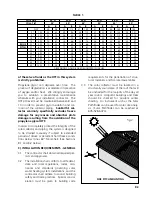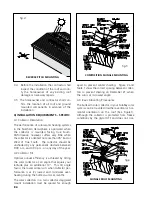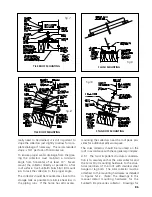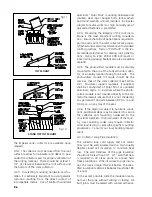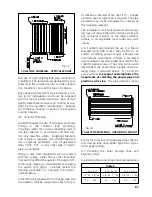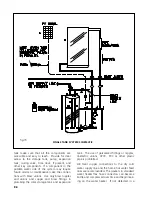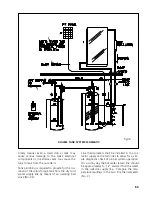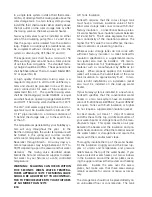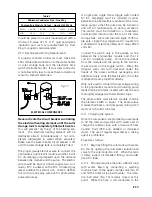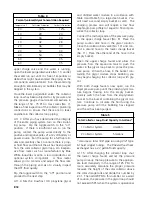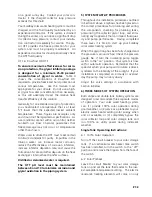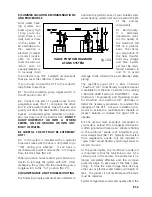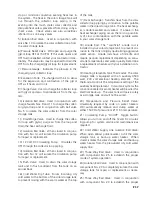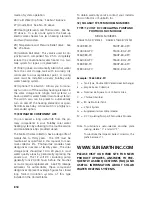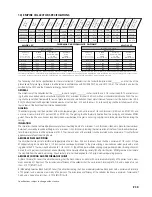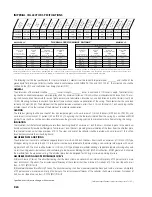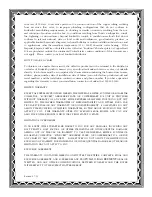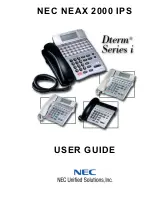
stop or minimize convective evening heat loss in
the system. The heat in the solar storage tank will
rise through the collector loop piping in the
evening into the much cooler solar collector and
dissipate heat unless prevented from doing so by a
check valve. Check valves are also sometimes
referred to as one way valves.
5) Isolation Ball Valve: Used in conjunction with
valve No. 10 to isolate the solar collector loop from
the solar storage tank.
6) Pressure Relief Valve: Will open and purge the
glycol loop HTF at 150 PSI. If this valve opens and
HTF fluid is expelled contact your contractor imme-
diately. This valve also may be opened to drain the
HTF from the charged glycol loop for replacement.
7) Pressure Gauge: Indicates the pressure in the
charged glycol collector loop.
8) Expansion Tank: Pre-charged with air to allow
for the expansion and contraction of the glycol
HTF as it heats and cools.
9) Charge Valve: Used to charge the collector loop
with glycol and also to eliminate air from the sys-
tem.
10) Isolation Ball Valve: Used in conjunction with
charge faucets Nos. 9 and 11 to charge the collec-
tor glycol loop and in conjunction with ball valve
No. 5 to isolate the solar collector from the solar
storage tank.
11) Drain/Purge Valve: Used to charge the collec-
tor loop with glycol, purge air from the loop and
drain the heat exchange fluid.
12) Isolation Ball Valve: When closed in conjunc-
tion with No. 14 will isolate the circulation pump
for repair or replacement.
13) 12 Volt DC Circulating Pump: Circulates the
HTF through the collector loop piping.
14) Isolation Ball Valve: When closed in conjunc-
tion with No. 12 will isolate the circulation pump
for repair or replacement.
15) Flush Valve: Used to drain the solar storage
tank and to flush sediment from the tank on an
annual basis.
16) Cold Water Dip Tube: Forces incoming city
cold water to the bottom of the solar storage tank
to prevent mixing with the warm water at the top
of the tank.
17) Heat Exchanger: Transfers heat from the solar
collector loop piping by conduction to the potable
water in the solar storage tank. The heat exchang-
er is double walled and vented. If a leak in the
heat exchanger piping occurs there is no possibili-
ty of cross contamination with the potable water
in your solar storage tank.
18) Anode Rod: The "sacrificial" anode rod is
installed in your solar storage tank to prevent cor-
rosion to the tank lining by neutralizing aggressive
water action. Anode rods have a finite life and
require periodic replacement depending on annu-
al tank temperatures and water quality. Determine
a replacement schedule with your installation con-
tractor.
19) Heating Element & Tank Thermostat: The solar
storage tank is equipped with an auxiliary 4500
watt, 230 volt electrical heating element. The
thermostat controls the temperature setting of the
auxiliary heating element. In two tank systems the
conventional electric water heater will be wired for
electrical back-up. The solar tank will serve solely
as a storage tank and will not be wired.
20) Temperature and Pressure Relief Valve:
Universally required by code on water heaters.
Will automatically release and dump water at
either 150 PSI of pressure or 210˚ F in temperature.
21) Circulating Pump "On/Off" Toggle Switch:
Allows you turn on and off the 12volt DC circulat-
ing pump for system service and maintenance as
required.
22) Cold Water Supply Line Isolation Ball Valve:
When open allows potable water to fill the solar
storage tank or back-up water heater. When
closed isolates the solar storage tank and back-up
water heater from the pressurized city cold water
supply line.
23) Three Way Ball Valve: Used in conjunction
with component No. 25 to establish the proper
mode of system operation.
24) Isolation Ball Valve: Used in conjunction with
component No. 23 to completely isolate the solar
storage tank for repair or replacement as neces-
sary.
25) Three Way Ball Valve: Used in conjunction
with component No. 23 to establish the proper
P.17

